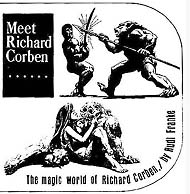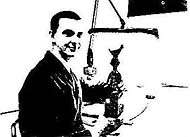![]()
Meet Richard Corben
The Magic World of Richard Corben
by Rudi Franke.
Copyright © 1970 Rudi Franke.
Appeared in Voice of Comicdom #16 (Winter 1970), pgs 3-4. Sorry poor quality of picts.
RUDI FRANKE: Well, to start off this interview Rich, a question that has always interested me is that of finding out when an artist started drawing as well as became involved with comic art.
 RICHARD CORBEN: I'm sure you've heard the answer to this one many times before. I started drawing long before I could read and write. I was always interested in story telling with my artwork. My elder brother had comicbooks, which I traced and copied the characters out of. The only ones I can remember are Superman, Tarzan, and Mickey Mouse. My first original comic strip was centered around my families pet dog Trail. About eight large issues of Trail Comics were produced before I went onto other things.
RICHARD CORBEN: I'm sure you've heard the answer to this one many times before. I started drawing long before I could read and write. I was always interested in story telling with my artwork. My elder brother had comicbooks, which I traced and copied the characters out of. The only ones I can remember are Superman, Tarzan, and Mickey Mouse. My first original comic strip was centered around my families pet dog Trail. About eight large issues of Trail Comics were produced before I went onto other things.
A typical beginning! How old are you then, and is there a chance that you too might have grown up on E.C. comics, such as I?
I'm just over 28. Yes, indeed! I especially liked their horror and Science Fiction lines. I didn't care too much for the crime stories. I remember that I was very upset when they went out of business.
As was I. I see a blend of many influences in your work, although you're style is fresh, new, vibrant, and dynamic. Do you have a list of artists that you advise?
Of the great nonliving artists, my favorites are: Da Vinci, Michelangelo, Caravaggio, Durer, Vermeer, Rembrandt, Rodin and Parish. The artists I most admire who are still alive and working are: Frank Frazetta, Wally Wood, and Alex Toth. I would like to believe that all of the above gentlemen have influenced my style, but I haven't consiciously tried to copy their work or style since I was in Art school.
And from what I've seen, you haven't. Really Rich, VoC is extremely fortuniate in having you. Your work is well done technically and has a great deal of polish. Have you had any art training.
I have a BFA from the Kansas City Art Institute.
I know that your hobbies include painting, drawing comic strips, and film making. Does your wife share your interests?
My wife, Dona, is very enthusiastic about my comic strip work. She is especially helpful with suggestions when I'm writing a story. We often discuss the work of various pro and fan artists. She actively participates in our film productions, not only with the creative end of production, but completely handles such mundane chores as securing materials and props, making arrangements with our friends to be actors and plays the role of the heroine in our latest film.
When did you begin film making and how many films have you made?
 You might say I started film making when I got my first movie camera which was about when I was a sophomore in High School. But I had been making flip page animation in the margins of books long before that. At first I animated isolated scenes from stories and although I enjoyed it very much, it wasn't very meaningful to anyone I showed the films to. During this time I was also doing a lot of work with animated models including clay snakes, rubber dinosaurs, Rubber Tarzan, and several Greek warriors made of wire and cloth. I finally decided that if I was ever going to impress anyone, I would have to film a complete story. That was Gateway to Terror adapted from a Science Fiction magazine story. After that I did The Labors of Hercules based on the Greek myths. With financial help from my father I switched to 16 mm and did several Horror live action films with some friends of mine. My last film, NeverWhere a combination of graphic animation and live action, won a CINE Golden Eagle and the President of the Japan Cultural Society award.
You might say I started film making when I got my first movie camera which was about when I was a sophomore in High School. But I had been making flip page animation in the margins of books long before that. At first I animated isolated scenes from stories and although I enjoyed it very much, it wasn't very meaningful to anyone I showed the films to. During this time I was also doing a lot of work with animated models including clay snakes, rubber dinosaurs, Rubber Tarzan, and several Greek warriors made of wire and cloth. I finally decided that if I was ever going to impress anyone, I would have to film a complete story. That was Gateway to Terror adapted from a Science Fiction magazine story. After that I did The Labors of Hercules based on the Greek myths. With financial help from my father I switched to 16 mm and did several Horror live action films with some friends of mine. My last film, NeverWhere a combination of graphic animation and live action, won a CINE Golden Eagle and the President of the Japan Cultural Society award.
Depending upon when you asked that question, you might get different answers. I go through phases of different interests. Generally Painting and comic art aren't nearly as demanding of my energy as film animation. This statement is more understandable if you consider that I made over 8,000 drawings for NeverWhere. On the other hand, animation is movement and when done well, animated characters have an almost magical life of their own.
Are you working on a film now? Is it being done in the same animation technique?
My wife, several friends and I are working on another film called Xenogames. It is completely different from the technique used in NeverWhere. Xenogames is a mixture of live action and animated models. It is a Science Fiction adventure story with Aliens, a space ship and a two-headed dragon. We are about one third into the production and don't expect to finish for at least another year.
Have you had much contact with fandom and fanzines?
The first fanzine I ever had was Dennis Cunningham's Weirdom. That was about two years ago. Dennis and I got together on a special Plague issue of Weirdom which was finally printed early in 1969 (Dennis there announced that it would be the last issue until he got out of the Army). Voice of Comicdom was the first fanzine to publish my strips, which was about the middle of '68. Presently, my work appears in VoC and Mark Franks fantafilmzine Photon. My wife and I attended our first convention at the World Con in St. Louis. We met quite a few there including Vaughn Bode, Jeff Jones and Larry Todd, as well as pro-publisher Jim Warren.
This issue, Rowlf is the special feature. How long have you been working on it?
Rowlf was first conceived a couple of years ago not as a comic story, but as a film. After several futile attempts at producing it, we gave it up for another script. After Monsters Rule was finished, I was looking for a story to appear in VoC and I remembered Rowlf. I gave this much thought and finally decided that I could do the story justice in the comic strip medium. Much preliminary work had already been done. This became very useful when adapting it to the comic strip. Several models of the characters had been built. These were now used to draw from. A friend of mine, Dave Holman, deserves all of the credit for designing the demons tanks and equipment, their characterizations and the plotting of certain scenes. It is difficult to say how much actual drawing time was spent on the final pages. I occasionally did two or three pages a week working evenings and weekends, but I didn't work on it constantly.
Your work is great. Tell me, have you had any professional appearances?
Only one in the field of magazines. That was a cover for [The Magazine of] Fantasy and Science Fiction which appeared on the September issue of 1967. In the field of industrial films my work appears anonymously in a great many films.
The next and last question really goes without asking, but here goes anyway. What are your future goals?
I would like to be a comic artist and cover artist but still have enough time to make films, or I would like to be a film producer and still have time to paint covers and draw comic strips.
And it looks like your goal is becoming a realization, as I understand Warren has just purchased one of your paintings. Now, onto a visual experience that you will not forget - a true graphic novel of historic importance. I present to you Rowlf, Part 1...
Copyright © 2004 Heart-Attack-Series, Ink!,
Created: October 12, 2004. Modified: January 15, 2019.
